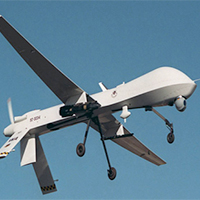More than 400 US drones crashed in past 13 years

More than 400 large US military drones have crashed around the world in the past 13 years, a Washington Post investigation has found.
The Post obtained documents detailing accidents including collisions with homes, farms, runways, roads, waterways and even an air force transport plane in midair. Several drones vanished while at cruising altitude and were lost.
In April, an army drone crashed next to an elementary-school playground in Pennsylvania; in 2012 an unmanned navy surveillance aircraft nose-dived and ignited a wildfire in Maryland.
Of the 418 major drone crashes since September 2001 that the newspaper identified, about half happened in Iraq and Afghanistan and nearly a quarter were in the US. Almost 200 of the crashes were classed by the military as “class A”, meaning they destroyed the aircraft or caused at least $2m-worth of damage, though no loss of life was attributed to the accidents. Problems included pilot error, mechanical failure and communications challenges.
Though unmanned aircraft have long been used by the US military in overseas operations and by US border patrol, their safety is of particular concern as they are set to become a common feature of civilian life in America within a couple of years.
The drone industry has lobbied US politicians to back commercial flights in the US, citing economic benefits. The online retailer Amazon, for example, is stepping up its efforts in Washington as it seeks to use drones for the swift delivery of its products to customers.
Congress told the Federal Aviation Administration to come up with a plan allowing commercial drones access to US airspace by September 2015, but the agency is unlikely to meet that deadline given the complexity of drafting safety regulations.
However, earlier this month the FAA gave permission for the first commercial drone to fly over US soil to BP, the oil and gas multinational, and AeroVironment, a California-based drone manufacturer. They are allowed to use a 4.5ft Puma drone to survey pipelines, road and equipment in Prudhoe Bay in northern Alaska.
Last December, the FAA selected six test sites that will continue their research until at least February, 2017. A team from Texas A&M University-Corpus Christi began operations in Texas on Friday and will gather data on weather patterns and the condition of oceans and wetlands.
However, a buzzing drone overhead is unlikely to become a common sight for tourists enjoying some of America’s most popular and iconic parks and monuments. The National Park Service is banning drones from more than 84m acres of public lands and waterways on the basis that they irritate visitors, harass wildlife and are potentially unsafe, it said in a statement on Friday.